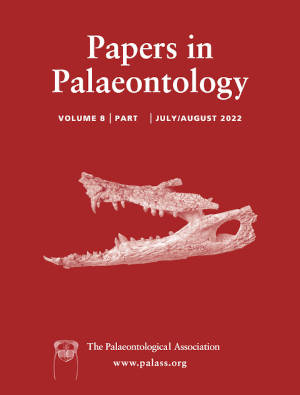Article: Vertebrate predation in the Late Devonian evidenced by bite traces and regurgitations: implications within an early tetrapod freshwater ecosystem
Publication: Papers in Palaeontology
Volume:
8
Part:
4
Publication Date:
2022
Article number:
e1460
Author(s):
Ninon Robin, Florian Noirit, Marion Chevrinais, Gaël Clément, and Sébastien Olive
DOI:
10.1002/spp2.1460
Abstract
Abstract The terrestrialization process by vertebrates occurred during the Devonian period, with fully land-dwelling tetrapods recorded in the Carboniferous. Thus, the Late Devonian is an important period for deciphering the ecological pressures that applied during the water-to-land transition. Higher predation pressures in the underwater environment have been suggested as an influential biotic evolutionary factor in this key habitat shift. Direct evidence of ancient predation on Palaeozoic vertebrates is seen in the form of rare traces preserved on fossils, and these range from trauma observed on the skeleton (such as attack marks) to ingested food remains (bromalites). The late Famennian freshwater ecosystem of Strud (Belgium) consists of a rich assemblage of many coeval gnathostomes or jawed fishes (placoderms, ‘acanthodians’, actinopterygians, and various sarcopterygian groups including tetrapods). Here we analyse the record of direct evidence for predation in the Strud vertebrate fossil assemblage. We recognize 12 regurgitalites and 13 bite traces, including a rare case of a tooth embedded in its original prey body target. Fossils from regurgitalites were imaged using scanning electron microscopy and chemically analysed to test for their possible ingestion signature by comparison with other isolated skeletal remains from the same locality. From this evidence, tristichopterid tetrapodomorphs are inferred to be the highest consumers of the trophic network, targeting small placoderms, and porolepiforms, and probably congeners. We observe two possible prey patterns in regurgitalites, for sarcopterygians and actinopterygians, both of which are associated with acanthodians. In Strud, no trophic position can be deduced for tetrapods from direct fossil evidence of predation.
